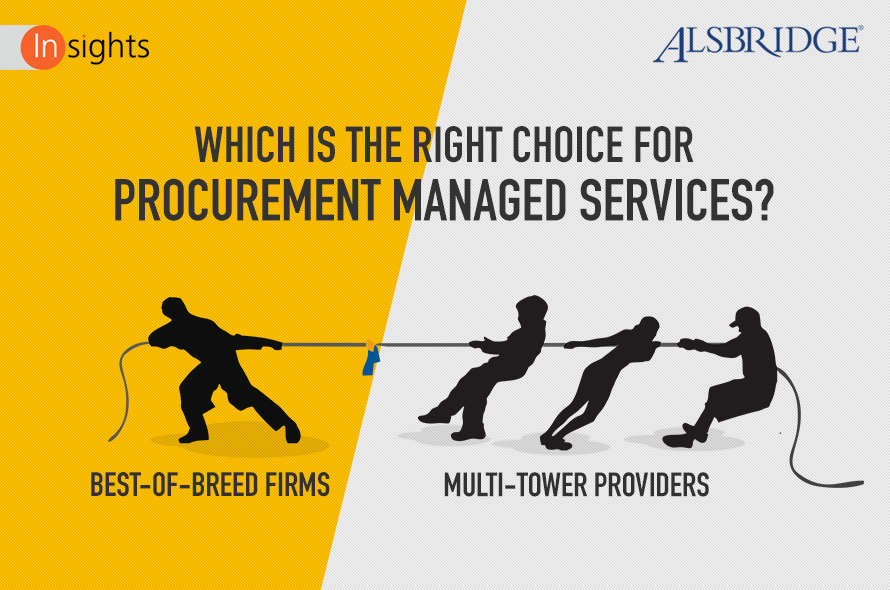In procurement discussions around the globe, the term “procurement managed services” is increasingly replacing “procurement outsourcing.” The reason, rightly so, is a simple one. While “outsourcing” suggests simply having a third party do equivalent work to what had previously been done internally, “managed services” generally involve an augmented or additional capability to business processes and systems, linked to specific outcomes that go beyond just cost savings. As enterprises continue to focus on optimizing core processes and improving agility in the digital age, this trend will only increase.
Procurement managed services include spend analytics, strategic sourcing, category management, spot buying, transactional procurement and contract administration. The terms “source-to-pay” (S2P), “source-to-contract” (S2C) and “procure-to-pay” (P2P) are commonly applied to Procurement Managed Services. The primary business objectives of procurement managed services are usually cost savings, risk management and compliance, along with reduced cycle times and an improved end-user experience.
There are a number of reasons to look at hiring a managed service provider to perform some or much of a company's procurement functions, especially in areas of indirect spend. Better market intelligence, availability of pricing and best practices data from doing many transactions across companies, strong analytics and process control capabilities, expertise on procurement tool sets, and a global delivery model are just some of the reasons why managed procurement services can be the right choice for many companies.
Enterprises seeking to improve their procurement capabilities through a managed service provider can consider a range of solution options, including whether to select a multi-tower generalist or a specialized, “best-of-breed” provider that focuses primarily on sourcing and procurement. Typically, a large generalist can deliver services across a range of towers, including other business process services, such as Finance & Accounting and HR Services, and IT Services, such as Infrastructure and Applications Services.
A multi-tower service provider can have hundreds of thousands of employees, as well as a brand that is a household name. The specialist, on the other hand, is likely to have fewer than 10,000 employees and is well known primarily to domain experts. The evolution of technology and the increasing maturity of the services industry merits a reconsideration of traditional assumptions.
Traditionally, the value proposition associated with selecting a large global service provider for procurement included the following:
- Aggregation of business with a single provider to achieve a lower cost rate card. In other words, higher volume with a provider yields a lower rate per resource.
- One throat-to-choke — by bundling services, there is presumed to be a single point of accountability, potentially across end-to-end services, as well as a more streamlined vendor management and governance model for the client.
- Getting leverage from the large volume of spend under management through the service provider.
- Availability of sourcing and procurement talent located across the globe, and therefore the ability to serve clients wherever they do business with local market knowledge and language skills.
- Process synergies across procurement, finance and IT, driving greater efficiency and optimization of processes with the enabling technology.
While all of these value propositions are theoretically possible, experience shows that most of them have a much smaller impact, if any, compared with expectations. Market experiences show that in fact:
Rate card economies of scale are often less than expected, and specialist providers are generally competitive, even when compared with large aggregated deals. Procurement engagements tend to be smaller scale from a headcount perspective — usually less than a few hundred, even at the high end — making staffing more manageable even for a specialized firm.
The primary benefit to the client from procurement managed services is savings on spend, rather than savings on the procurement function itself (i.e. labor arbitrage). Nonetheless, because procurement skills are better understood; therefore, quite possibly, more highly valued at the C-Suite of a specialist, a more focused firm can potentially attract and retain some of the best domain talent at a competitive labor rate.
- Most large multi-tower providers have different reporting structures for their various service lines, each with different goals and relatively few meaningful incentives for each to collaborate with each other. So, even if the account representative serves as the client's “single throat”, that representative is faced with the daunting task of navigating the politics of multiple chains of command in his or her company, which only converge at the C-Suite. This reality can limit the representative's ability to be responsive, regardless of his or her intentions.
- Most sourcing is specific to each client. With the exception of express “consortium spend”, expertise and client intimacy — more often than not — trump any perceived market-mover effect.
- Global sourcing deals tend to follow an 80/20 rule, with the vast majority of spend limited to a few major countries. Often, countries with minor spend are excluded from scope, or served at a more basic level to ensure regulatory and risk compliance, but little more. Typical procurement managed services delivery models cluster operational resources in a small number of lower cost locations and distribute sourcing resources at or near the client's primary centers of major spend. In other words, even if a large provider has resources on the ground in a small country, they are rarely included in the staffing model because their cost cannot be justified by the amount of spend at those smaller locations.
- For reasons similar to point number two above, process synergies — while a good idea — often fail to materialize at a significantly different rate from synergies where there are multiple providers involved.
Fact is, when selecting a procurement managed service provider, the answer is not “multi-tower” or “specialist” but rather who will be the right fit for your organization. Smaller firms may not be household names, but pound for pound, they can usually bring a high caliber of specialized talent. And, with shorter reporting structures, they can often achieve a very high degree of strategic alignment with their clients.
So, when selecting a provider, look beyond brand, size and scale, and take the time to fully understand the capabilities, the delivery model options, and, most importantly, the specific talent who will be working on your account, irrespective of whether your provider is a company of 400,000 or 4,000 or 400.
About the Author
Bill Huber, Managing Director with Alsbridge, held high-profile positions in procurement leadership at several major U.S. companies prior to his ongoing success on the consulting and advisory side of the business. Bill is a recognized thought leader and sought-after speaker at major industry events.

